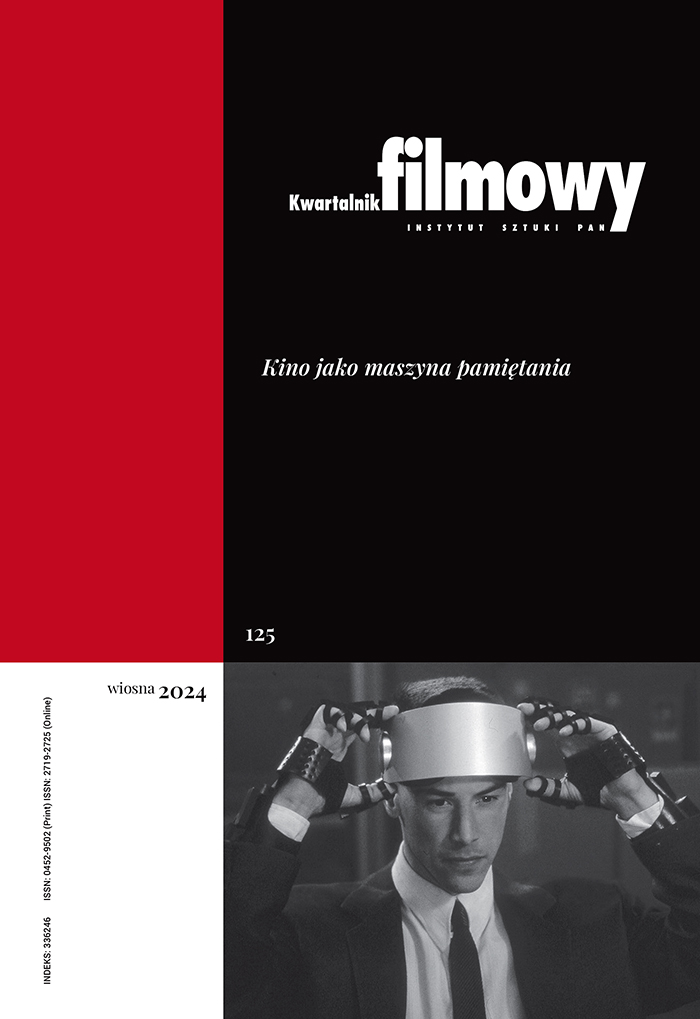Człowiek zurbanizowany. Shinya Tsukamoto i jego filmy
Abstrakt
Tematem filmowej twórczości Shinyi Tsukamoto jest oddziaływanie zurbanizowanego, ulegającego technologicznym przemianom otoczenia na jego mieszkańców. Obszarem tych przemian jest w filmach japońskiego twórcy ludzkie ciało. Reżyser opisuje kryzys odczuwania cielesności, właściwy mieszkańcom nowoczesnych metropolii, proces odzierania z fizycznych doznań, których miejsce zajmuje zautomatyzowana egzystencja. Bohaterowie Tsukamoto traktują swoje ciała jak maszyny – nieustannie je udoskonalają, aby pasowały do otoczenia, w którym nieobecne są wszelkie znamiona rozkładu. Reżyser wytrąca swoich bohaterów z niebezpiecznego marazmu i ukazuje ich przemianę, pozwalającą na osiągnięcie cielesnej samoświadomości. W twórczości Tsukamoto widoczna jest ewolucja motywu przemiany ludzkiego ciała: od totalnej modyfikacji, poprzez akceptację jego organicznej proweniencji, aż po refleksję natury metafizycznej. Autorska wizja japońskiego twórcy stanowi ważny głos w filmowym opisie kondycji współczesnego człowieka.
Słowa kluczowe:
Shinya Tsukamoto, ciało, alienacja, kino japońskieBibliografia
Nie dotyczy / Not applicable
Google Scholar
Autorzy
Agnieszka Kamrowskakwartalnik.filmowy@ispan.pl
Uniwersytet Jagielloński Polska
Doktorantka Instytutu Sztuk Audiowizualnych UJ, przygotowuje pracę doktorską poświęconą motywom cyberpunkowym w kinie Wschodu i Zachodu.
Statystyki
Abstract views: 225PDF downloads: 128
Licencja
Prawa autorskie (c) 2005 Agnieszka Kamrowska

Utwór dostępny jest na licencji Creative Commons Uznanie autorstwa 4.0 Międzynarodowe.
Autor bądź autorka udziela wydawcy niewyłącznej i nieodpłatnej licencji (CC BY 4.0) na wykorzystanie tekstu w „Kwartalniku Filmowym”, zachowuje nieograniczone prawa autorskie i zobowiązuje się do podawania miejsca pierwodruku przy ponownym wykorzystaniu artykułu (umowa licencyjna do pobrania). Czasopismo jest wydawane na licencji CC BY 4.0. Zgłaszając artykuł do publikacji, autor bądź autorka wyraża zgodę na jego udostępnianie na tej licencji.
W wydaniach od 105-106 (2019) do 119 (2022) wszystkie artykuły były publikowane na licencji CC BY-NC-ND 4.0. W tym okresie autorzy i autorki udzielali(-ły) niewyłącznej i nieodpłatnej licencji (CC BY-ND 4.0) na wykorzystanie tekstu w „Kwartalniku Filmowym”, zachowywali(-ły) nieograniczone prawa autorskie i zobowiązywali(-ły) się do podawania miejsca pierwodruku przy ponownym wykorzystaniu artykułu.
Inne teksty tego samego autora
- Agnieszka Kamrowska, „Happy Together” - chińskie kino drogi , Kwartalnik Filmowy: Nr 107 (2019): Podróż, (e)migracja, pielgrzymka
- Agnieszka Kamrowska, Filmy AI: kino z doliny niesamowitości , Kwartalnik Filmowy: Nr 130 (2025): Nowa gatunkowość
- Agnieszka Kamrowska, Teatr bunraku w filmie „Lalki” Takeshiego Kitano , Kwartalnik Filmowy: Nr 87-88 (2014): Film i teatr
- Agnieszka Kamrowska, Metafizyka natury. Motywy shintoistyczne w anime Hayao Miyazakiego , Kwartalnik Filmowy: Nr 96 (2016): Film i metafizyka
- Agnieszka Kamrowska, Amerykańskie przebudzenia. Transgresja ideologiczna w filmach Davida Finchera , Kwartalnik Filmowy: Nr 49-50 (2005): Ideologia i film
- Agnieszka Kamrowska, Dzieci apokalipsy. Atomowa trauma jako motyw japońskiej animacji , Kwartalnik Filmowy: Nr 61 (2008): Trwoga, lęki, niepokoje
- Agnieszka Kamrowska, Mechanika i anatomia. Wideoklipy i instalacje Chrisa Cunninghama , Kwartalnik Filmowy: Nr 53 (2006): Kino brytyjskie (cz. II)











